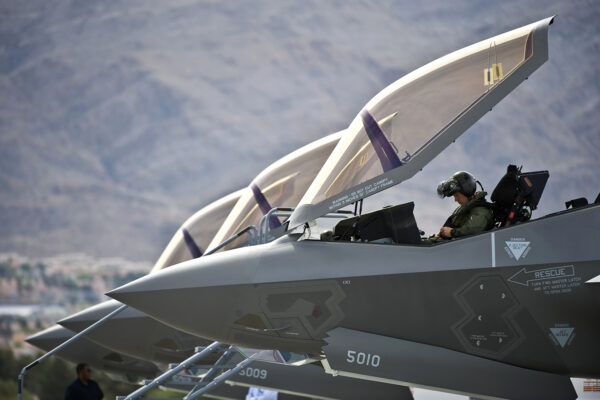
Major Akinori Hosomi vanished on a cool evening in April 2019 while flying one of the world’s most modern and deadliest aircraft — the F-35A Joint Strike Fighter.
When the 41 year-old pilot took off from Misawa Air Base in northern Japan on the night of April 19, there was little sign of trouble. An experienced pilot with sixty hours on the F-35A, the multirole jet he was flying was state-of-the-art and the mission profile was to be another routine night-training exercise. Yet his plane fell into the Pacific Ocean without so much as a distress call on the part of the pilot.
Akinori Hosomi’s remains were recovered from the seabed months later leaving behind a mystery about the first fatal crash for the Pentagon’s most expensive weapons system.
Halt
Japanese authorities later revealed that the 41 year-old pilot likely suffered from vertigo or “spatial disorientation” after taking off from Misawa Air Base. His multirole fighter is believed to have suffered from navigational and cooling errors before the crash. Throughout the course of the investigation and recovery, potential salvage efforts by a hostile power remained a significant concern for both Tokyo and Washington.
Hosmi’s nighttime crash led to a four-month halt to all F-35 flights by Japan’s Air Self-Defense Force (JASDF). The crash represents the most fatal part of Japan’s troubled relationship with one of the world’s most expensive warplanes. The helmet alone, filled with advanced sensors, costs $400,000.
This summer the US Department of State approved a $23 billion plan for Japan to acquire 105 Lockheed Martin F-35 stealth fighters of both the conventional takeoff (the F-35A) and the short takeoff and vertical landing variant (the F-35B).
As a result of this deal, Japan is now home to one of only two F-35 production final assembly and checkout facilities located outside of Fort Worth, Texas, where Lockheed Martin maintains the primary F-35 production facility.
However, like its European counterpart, production in Japan was forced to shut down earlier this year owing to the onset of the COVID-19 pandemic. The impact of the virus has also delayed the training of the JASDF’s F-35 test pilots due to concerns about virus transmission among this most elite cadre of pilots. The backlog will last until at least 2023 and extend the date the jets will enter active services with the Self-Defense Force.
Next stealth plane
By then, Japan may be well into the development of its next system: the F-X development program, a next-generation warplane developed by local industry. Japan is currently seeking to develop a domestically produced stealth fighter, alternatively known as the F-X or F-3. The project has surprised some analysts given that Japan canceled plans for X-2 stealth fighter prototypes in 2018.
Mitsubishi Heavy Industries is now in pole position on a $40 billion contract for that program after developing the X-2 prototype in 2016. Northrup Grumman, Lockheed Martin and BAE systems had all floated offers but, so far, Japan has decided to go it alone on its new fighter that will complement its inventory of F-35s.
Since the end of the Second World War, Japan has only developed two combat aircraft, the F1 (developed in 1975) and the F-2 (derived from the F-16, which entered service in 2006). The latter is likely to be phased out by the end of the current decade.
The development of multiple airframes might be to Japan’s advantage. The F-35’s advanced sensor capabilities may mean that it would work better in formations where it uses its sensors to see over the horizon and “quarterback” information and roles of the other aircraft in the formation.
“The F-35 program is an important one,” says Jon Grevatt, a Bangkok-based Asia-Pacific defense industry analyst, “but even more important for Japan is the development of the F-X development program, which seeks for Japan to develop a next-generational multirole fighter domestically. While the timeline on that project is developing, the F-35 is likely to be critical to the security aspirations of Japan over the next two decades.”
New chapter
The development of the F-X or F-3 will open a new chapter in Japan’s defense history. After World War II, Japan adopted a pacifist constitution that limits the role of its military. As a result, Japan only began weapons exports in 2014 under former Prime Minister Shinzō Abe.
Given the general relaxing of Japan’s pacifist structures over recent decades, including refitting the Izumo class helicopter destroyers as aircraft carriers equipped with the F-35B, the F-X fighter, when completed, could also be a target for high-end export to third countries.
Ironically, it was the issue of arms exports that placed the Japanese defense industry in this position. Japan’s Ministry of Defense was interested in purchasing the F-22 Raptor, but the Obey Amendment of the US Congress prevents the export of this aircraft even to close treaty allies.
With that in mind, Japan is likely to continue seeking partners — the United States or the United Kingdom could potentially play a role in the project. In particular, a joint effort with Britain would be politically useful for both countries. The United Kingdom is currently working on its advanced fighter jet, Tempest, a twin-engine, delta-winged, low-observable fighter, opening another possible avenue for partnership.
Meanwhile, Japan’s Acquisition, Technology and Logistics Agency (ATLA) made clear it was open to partnering with either country in statements this year, but a final decision will not be reached until December 2020 at the earliest. In the meantime, Japan has a lot of F-35s to build.
This story first appeared in The Mallard, October 16, 2020.
